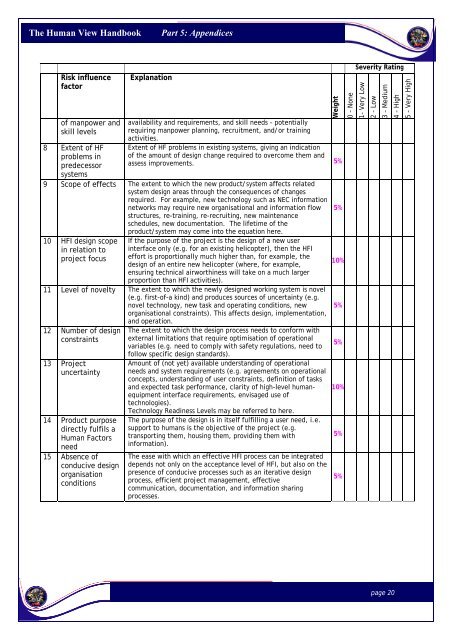The Human View Handbook for MODAF: Part V â Appendices
The Human View Handbook for MODAF: Part V â Appendices
The Human View Handbook for MODAF: Part V â Appendices
Create successful ePaper yourself
Turn your PDF publications into a flip-book with our unique Google optimized e-Paper software.
<strong>The</strong> <strong>Human</strong> <strong>View</strong> <strong>Handbook</strong><br />
<strong>Part</strong> 5: <strong>Appendices</strong><br />
Risk influence<br />
factor<br />
of manpower and<br />
skill levels<br />
8 Extent of HF<br />
problems in<br />
predecessor<br />
systems<br />
Explanation<br />
availability and requirements, and skill needs – potentially<br />
requiring manpower planning, recruitment, and/or training<br />
activities.<br />
Extent of HF problems in existing systems, giving an indication<br />
of the amount of design change required to overcome them and<br />
assess improvements. 5%<br />
9 Scope of effects <strong>The</strong> extent to which the new product/system affects related<br />
system design areas through the consequences of changes<br />
required. For example, new technology such as NEC in<strong>for</strong>mation<br />
networks may require new organisational and in<strong>for</strong>mation flow<br />
structures, re-training, re-recruiting, new maintenance<br />
schedules, new documentation. <strong>The</strong> lifetime of the<br />
product/system may come into the equation here.<br />
10 HFI design scope<br />
in relation to<br />
project focus<br />
If the purpose of the project is the design of a new user<br />
interface only (e.g. <strong>for</strong> an existing helicopter), then the HFI<br />
ef<strong>for</strong>t is proportionally much higher than, <strong>for</strong> example, the<br />
design of an entire new helicopter (where, <strong>for</strong> example,<br />
ensuring technical airworthiness will take on a much larger<br />
proportion than HFI activities).<br />
11 Level of novelty <strong>The</strong> extent to which the newly designed working system is novel<br />
(e.g. first-of-a kind) and produces sources of uncertainty (e.g.<br />
novel technology, new task and operating conditions, new<br />
organisational constraints). This affects design, implementation,<br />
and operation.<br />
12 Number of design<br />
constraints<br />
13 Project<br />
uncertainty<br />
14 Product purpose<br />
directly fulfils a<br />
<strong>Human</strong> Factors<br />
need<br />
15 Absence of<br />
conducive design<br />
organisation<br />
conditions<br />
<strong>The</strong> extent to which the design process needs to con<strong>for</strong>m with<br />
external limitations that require optimisation of operational<br />
variables (e.g. need to comply with safety regulations, need to<br />
follow specific design standards).<br />
Amount of (not yet) available understanding of operational<br />
needs and system requirements (e.g. agreements on operational<br />
concepts, understanding of user constraints, definition of tasks<br />
and expected task per<strong>for</strong>mance, clarity of high-level humanequipment<br />
interface requirements, envisaged use of<br />
technologies).<br />
Technology Readiness Levels may be referred to here.<br />
<strong>The</strong> purpose of the design is in itself fulfilling a user need, i.e.<br />
support to humans is the objective of the project (e.g.<br />
transporting them, housing them, providing them with<br />
in<strong>for</strong>mation).<br />
<strong>The</strong> ease with which an effective HFI process can be integrated<br />
depends not only on the acceptance level of HFI, but also on the<br />
presence of conducive processes such as an iterative design<br />
process, efficient project management, effective<br />
communication, documentation, and in<strong>for</strong>mation sharing<br />
processes.<br />
Weight<br />
5%<br />
10%<br />
5%<br />
5%<br />
10%<br />
5%<br />
5%<br />
Severity Rating<br />
0 - None<br />
1- Very Low<br />
2 - Low<br />
3 – Medium<br />
4 - High<br />
5 – Very High<br />
page 20
















